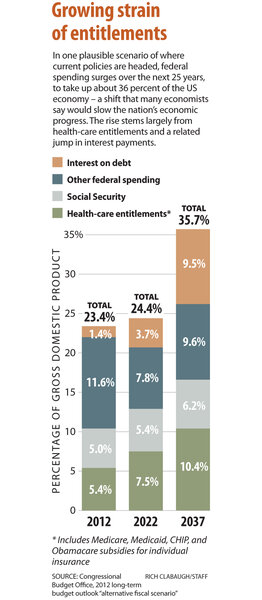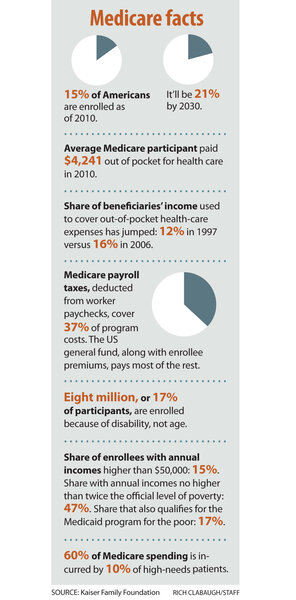Taming Medicare costs: What are the options?
Loading...
For a quick glimpse of America's health-care challenge, consider this: The nation spent $8,233 per person on medical care in 2010 – more than twice the average of other advanced economies, including Germany, Britain, Canada, and Japan.
America doesn't have bad health care, judging by life expectancies that are on par with other nations, but it does have notably expensive health care.
And a lot of the payment burden rests on the US government, through entitlement programs including Medicare for seniors and Medicaid for the poor. If this problem isn't addressed as baby boomers retire, it's a recipe for deep trouble for taxpayers and the US economy.
Medical costs are high and rising for reasons that go beyond the demographics of an aging nation. At the individual level, doctors and patients together are opting for a greater volume of health-care services. Some of that, economists say, reflects people buying improved health care as their incomes rise. Some reflects wasteful decisions that don't improve health outcomes.
And beyond the number of patients treated and the volume of care each receives, researchers see another factor: Hospitals and doctors in the United States have a pricing power that they simply lack in other nations.
"The reason the US spends so much more per capita and as a percentage of GDP than other countries is not because we do that many more services.... It's because our prices are higher than anybody else's," says Robert Berenson, a health-care expert at the Urban Institute in Washington. "Physicians' incomes are at the high end.... Nursing income is at the high end. Hospital executive salaries are way over the high end."
Health care at all levels, from a consumer's co-payment to the billions spent by government, now accounts for 18 percent of gross domestic product – almost $1 in every $5. That's up from 7 percent of GDP in 1970. Several in-depth studies have concluded that as much as one-third of overall US health-care spending – and possibly of Medicare spending – is wasteful and does nothing to improve the quality of care.
That doesn't mean it's easy to cut costs 30 percent or more.
"There is no silver bullet" solution, says Elliott Fisher, a health policy expert at Geisel School of Medicine at Dartmouth College in Hanover, N.H. But "solving the fiscal crisis that is posed by rising health-care costs is incredibly important."
To a large degree, all the budgetary bluster and hand-wringing by politicians this year boils down to a simple but vexing question: How should the US reform these programs that millions rely on, so that benefits are provided without breaking the nation's bank?
Yes, the fiscal debates also include important attention to tax reform and spending on everything from defense to farm subsidies. But entitlements, particularly in health care, are the elephant in the room.
The outlook isn't all financial gloom. The growth of Medicare costs, per beneficiary, has slowed in the past few years. And although there's no guarantee that trend will continue, many health policy experts say tallies of waste or overpricing are evidence that there's considerable room for restraining costs.
Mr. Berenson and some of his colleagues at the Urban Institute have proposed an action menu that could cut projected Medicare spending by some $300 billion (a 4 percent cut) or more over the next decade, with minimal impact on benefits.
Some steps are as simple as saying "no" to traditional practices, such as Medicare payments that indirectly support medical education. While still investing in the most-needed doctor training, the US government could save some $50 billion over 10 years from that step alone, Berenson's report estimated.
The entitlement time bomb
Before delving deeper into potential solutions, though, it's important to set this issue of entitlement reform in context. Why is it so important? How big do the changes need to be?
The very word "entitlement" is controversial. To some Americans it carries the pejorative notion of people mooching off the federal government, while others grow defensive about benefits they feel they've paid for.
Like it or not, though, "entitlements" is the ubiquitous term for some very costly programs that channel benefits from the government to ordinary Americans. And the fact is, the typical Medicare beneficiary, despite contributing payroll taxes during working years and premiums during retirement, doesn't come close to covering the whole tab.
Medicare, with 50 million beneficiaries and rising to 80 million by 2037, is the biggest "entitlement bomb" in the federal budget. But it's not the only one. Social Security is also projected to stake a rising claim on the nation's financial resources over the next decade and beyond.
Medicaid, though less talked about, is an important piece of the puzzle. It's smaller in scale than Social Security or Medicare, aiming at a narrower slice of the population. But as the safety net for the poor, it increasingly serves as the backstop when seniors run out of money for costs not covered by Medicare. Medicaid spending has been rising steadily, and options for cost savings may be few.
With the two political parties split on whether more tax revenue should be part of the fix, it's not clear whether President Obama and Congress will make any legislative headway toward entitlement reform this year.
A report last year by the nonpartisan Congressional Budget Office (CBO) put the consequences of political inaction in sharp relief, noting that the fiscal hole gets deeper the longer America waits. In one scenario reflecting status-quo fiscal policies, corrective action taken this year (tax hikes or spending cuts, or both) would need to equal more than 4 percent of GDP through 2037 in order to keep the national debt stable as a share of GDP.
That's big. But if politicians were to postpone action for a dozen years, until 2025, the CBO says the tax or spending changes would need to be bigger still – twice as large to reach the same debt target by 2037.
How to tame the Medicare beast?
The same forecasts show how central health-care entitlements are to America's rising debt challenge.
During that period, from today through 2037, health-care entitlements alone could nearly double in size to 10.4 percent of GDP, according to the CBO. Social Security, too, is on track to expand in size to 6 percent of GDP, compared with 5 percent today. Yet overall federal tax revenues currently look set to total only about 19 percent of GDP.
Sherry Glied, a professor of health policy at Columbia University in New York, says the options for cost control fall into three broad categories. The first is to try to nudge prices downward, such as by tinkering with government payment rates to care providers. The second is to try to change the way care is delivered, in ways that give providers incentives to improve quality and reduce costs. The third is to take the government off the hook, by shifting more of the cost burden to consumers.
In the end, it may be that a mix of all three is deployed. But Ms. Glied argues that, because the government has focused on Option 1 in recent years, the big effort for now should go toward Option 2.
Already, Mr. Obama's 2010 Affordable Care Act contains some initiatives on this track. The Center for Medicare & Medicaid Innovation, for one, is working to spread promising models of care and cost control.
But health experts say more steps will be needed. Among the many new ideas, a few might have broad – but hard to quantify – impacts on the behavior of health-market participants like physicians, hospital administrators, and patients.
Here are prominent examples that may have potential to gather bipartisan support:
1. Pay for quality, not quantity of services
In Medicare's traditional "fee for service" model, the financial incentives tilt toward doing that extra test or procedure when in doubt. Reform proponents say the better way involves approaches that pay increasingly for the quality of patient care, rather than its quantity – and which offer incentives for teamwork and information-sharing among health-care professionals.
"That's the single most important thing we could do," says John Rother, president of the National Coalition on Health Care, which represents a wide range of stakeholder groups.
Some proponents urge payment reforms – both within and outside Medicare – that encourage providers to accept a single in-advance fee for each person in their care. If the organization keeps costs down, it pockets a higher profit. If its care is excellent, more customers will come through the doors. This is the "accountable care organization" model, which is getting a test run in Medicare under the Affordable Care Act.
2. Use antitrust law to boost competition
Whether in or out of Medicare, the idea of giving providers incentives to hold costs down works best when providers have to compete with one another for business. But in many markets, competition among health-care providers is relatively limited – partly because of a trend of consolidation among hospitals as well as insurers.
Leemore Dafny, a Northwestern University economist who's serving as deputy director of health care and antitrust at the Federal Trade Commission, says it's not too late for antitrust efforts to play an important role in fostering competitive markets for health care.
"The last couple of years have seen a turn toward more successful enforcement" efforts, she says.
3. Engage the consumer
Many reform proposals hinge on the idea of enlisting the consumer to be more cost-conscious.
For instance, when Medicare beneficiaries buy supplemental "Medigap" insurance, they are largely shielded from out-of-pocket costs – leaving little financial incentive to restrain their use of medical services.
The Urban Institute's Berenson suggests a rule change for these policies, so that policyholders would have to pay at least half of the first $4,950 in Medicare expenses. Backers of this general approach add a caveat, though: The challenge is that cost-conscious consumers may forgo needed as well as unneeded care.
Whatever paths are pursued, Medicare is sure to keep evolving.
"We've been making tough choices in the Medicare program since five years after it started," Glied says, "and we're never going to stop."








